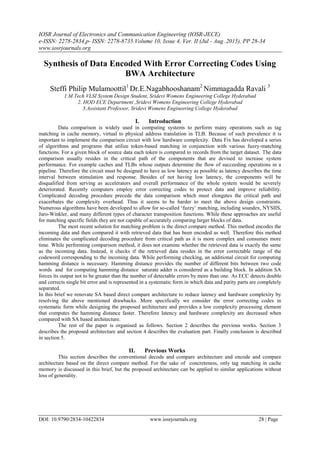The document summarizes a proposed architecture that uses Butterfly Weight Accumulators (BWAs) to improve the latency and complexity of computing the Hamming distance when comparing data encoded with error correcting codes. Specifically, it recognizes that error correcting codes are often represented in a systematic form where the data and parity parts are separated. The proposed architecture leverages this by starting the data comparison before fully encoding the parity bits, reducing latency. It also uses BWAs as processing elements that can compute Hamming distance faster than previous saturating adder-based approaches. The architecture is analyzed theoretically and shown to reduce latency and complexity compared to prior direct compare methods.





![Synthesis Of Data Encoded With Error Correcting .......
DOI: 10.9790/2834-10422834 www.iosrjournals.org 33 | Page
C. General Expressions for the Complexity and the Latency
The complexity as well as the latency of combinational circuits heavily depends on the algorithm
employed. In addition, as the complexity and the latency are usually conflicting with each other, it is
unfortunately hard to derive an analytical and fully deterministic equation that shows the relationship between
the number of gates and the latency for the proposed architecture and also for the conventional SA-based
architecture. To circumvent the difficulty in analytical derivation, we present instead an expression that can be
used to estimate the complexity and the latency by employing some variables for the nondeterministic parts. The
complexity of the proposed architecture, C, can be expressed as
where CXOR, CENC, C2nd, CDU, and CBWA(n) are the complexities of XOR banks, an encoder, the second level
circuits, the decision unit, and a BWA for n inputs, respectively. Using the recurrence relation, CBWA(n) can be
calculated as
where the seed value, CBWA(1), is 0. Note that when a + b = c, CBWA(a) + CBWA(b) ≤ CBWA(c) holds for all
positive integers a, b, and c. Because of the inequality and the fact that an OR-gate tree for n inputs is always
simpler than a BWA for n inputs, both CBWA(k) + CBWA(n –k) and C2nd are bounded by CBWA(n). The latency of
the proposed architecture, L, can be expressed as
where LXOR, LENC, L2nd, LDU, and LBWA(n) are the latencies of an XOR bank, an encoder, the second
level circuits, the decision unit, and a BWA for n inputs, respectively. Note that the latencies of the OR-gate tree
and BWAs for x ≤ n inputs at the second level are all bounded by [log2 n]. As one of BWAs at the first level
finishes earlier than the other, some components at the second level may start earlier. Similarly, some BWAs or
the OR-gate tree at the second level may provide their output earlier to the decision unit so that the unit can
begin its operation without waiting for all of its inputs. In such cases, L2nd and LDU can be partially hidden by
the critical path of the preceding circuits, and L becomes shorter than the given expression.
IV. Proposed BWA Architecture
The above BWA architecture describes the operation of (8,4)code. The same architecture with some
extensions is used to built the proposed architecture. Proposed architecture describes the analysis of
(16,11),(24,18)and(40,33)code. The above mentioned (8,4) code takes only 8 bits of code words. Besides, the
proposed architecture increases the bit length of the code words so that we can process more information.
Fig 8(a): BWA For Parity of (16,11)code](https://image.slidesharecdn.com/e010422834-160805095628/85/E010422834-6-320.jpg)
